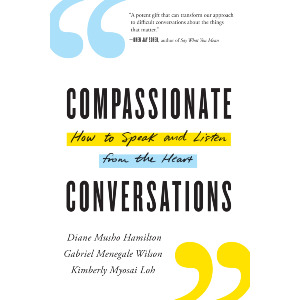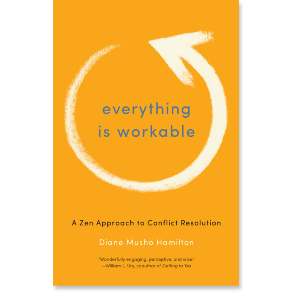This article is the third in a series of three, sharing perspectives from the book Compassionate Conversation: How to Speak and Listen from the Heart, co-authored by Diane Musho Hamilton, Gabriel Menegale Wilson, and Kimberly Myosai Loh.
Read the first article in the series, “What Makes a Successful Conversation?”
Read the second article in the series, “Conversation Skills to Catalyze Growth”
Across the world, our ways of holding power have evolved enormously in even the last 100 years. Trends in governance demonstrate how we’re moving away from dictatorships and autocracies. The waves of revolutions and social change movements show us that people are no longer submitting to being ruled solely by force and fear. Instead, capturing the hearts of those we may seek to guide and direct is vitally important. This means that people’s core needs, values, and potential must be woven into the shared path forward.
Anytime we are providing direction, advancing the path, or offering our vision in service of a collective group, we are expressing leadership traits. The way we communicate with others involved has everything to do with the success or failure of our proposition.
What Does it Mean to Lead from a Place of Wholeness?
Wholeness is the inclusion of all parts into a cohesive entity. It’s drawing the pieces together to feel their fullness, unified in one place. Both relieving and empowering, it is both a concept and a practice.
Leading a team is complex. When leading, it’s vital to understand the context in which one is navigating: the mapping of connection points and levers, the timeliness of action, and the availability of resources. We must also grasp our internal landscape: the team’s individual and collective strengths, all of the myriad interrelationships, systems of operation, and, importantly, how aligned each person is with the common intention or aspiration. While it’s a lot to take in, we can keep some priorities in mind.
Leaders who lead from a place of wholeness are guided by three important traits:
1. Conscious, clear values
Values in this context are simply what one considers most important. In this article I’m choosing to focus on humility, integrity, and ethical intelligence as examples, but it is for each person to choose for themselves what values they subscribe to and how they will hold themselves accountable. If we accept that power brings with it responsibility, leaders must take on the additional responsibility of ensuring that their decisions are being made in line with chosen value sets, and not consciously or subconsciously corrupted by self-interest.
Humility is the knowledge that each of us is subject to our own limitations. Once we recognize this, we can become curious about opening to others’ perspectives so that we can gain a fuller, more accurate picture of reality. When we can incorporate more points of view, especially from those whose lives will be impacted by those decisions, our strategies and solutions will become more durable and effective.
Integrity guides us to stay true to carefully chosen values and principles that are appropriate for the needs of all relevant stakeholders, even when the circumstances don’t feel convenient. Having a strong sense of integrity is what makes us reliable. In times of increased fear and volatility, being able to trust in our leaders to keep what’s most important squarely at the fore is absolutely invaluable.
Ethical intelligence refers to the soundness of the process we go through in discerning what our chosen values and principles are. For some, this uncovering process is a foundational commitment throughout our life’s work. We can hone our moral compasses by ensuring we take the time to question for ourselves what we believe to be right and why, rather than relying on common opinion.
2. Mature communication skills
In Compassionate Conversations, we discuss basic communication skills, such as listening, reframing, and working with strong emotions. We also discuss more nuanced skills, such as perspective-taking and working with power. In my previous article I explored and offered reflection questions for practicing the key skills of Listening Well, Talking Straight, and Giving Support and Challenge. Other important domains of practice for leaders include giving and receiving feedback, cultivating emotional maturity, and using language skillfully to engage, guide, and motivate members of the team.
While we all benefit from doing this work, leaders have the potential to amplify those benefits because they are modeling a culture of communication for the entire company or organization. When the person in charge habitually interrupts others and diminishes their opportunities to contribute, they are sending a signal about what kinds of behavior are acceptable, and whose voices are worthy of listening. However, if that person instead makes a habit of actively listening to others and seeking their inputs while staying oriented to the main purpose of the group, they are communicating that they care about others’ insights as they discern how to proceed on that issue.
3. Continual development
Leaders who consciously engage their own process of evolution potentiate their growth and allow them to access new perspectives that can inform how they think and act. Here is a passage from Compassionate Conversations that expresses how adult development expands us to include more.
At one time, human development was thought to be complete with adolescence. But research shows that it continues throughout the entire adult life span. (1) . . . In one model of adult development, identity moves through four basic stages: egocentric, ethnocentric, worldcentric, and Kosmocentric.
Through this simple model our sense of self grows from smaller to larger, encompassing more and more experience. As the sense of self becomes more expansive, it also becomes less fixed and more flexible.
These developmental waves of identity have powerful implications for conversation, and while they cannot capture the totality, uniqueness, or mystery of any particular person, they reveal certain broad patterns that can help us understand why our conversations often take the turns they do. (2)
As we describe, development is strongly linked to our notion of identity: who we believe and say we are, our values, and how much we might cling to that. (3) The counterpoint to this mode of being is flexibility. As we practice our willingness to shift away from ways we’ve habitually performed in the past, we can transform in the direction of becoming the leader who is actually needed in the moment.
The beauty of this is that not only are we more available and responsive to what our environments are calling forward from us, but we actually align with the true nature of reality itself. The world, nature and culture are all evolving, and so are we.
Closing the Loop
As a leader, your approach to relationships and communication is mirrored by others throughout your organization. In the complexity of today’s world, anchoring your values in what you deem to be most important will support the soundness of your decisions and others’ ability to rely on you. Committing to practice communication skills and continually grow will show you results over time. People desire to be led by inspiration and emotional connection. When you come from a place of greater wholeness, then you will be able to engage others more deeply and incorporate differences in an interdependent flow. In so doing, you can reduce unintended consequences or harms, and genuinely create better outcomes for everyone involved.
The Practice
Think of a situation in which you have influence where you feel challenged in taking in other points of view and might be defending what you think is the “right way.” Take the time to journal responses to the following prompts, as applied to your scenario:
1. Consciously choose your values
- What values are you relying on?
- What values are others expressing through their points of view?
- Are these sets of values mutually exclusive? Is it possible to weave these values together into a path forward?
2. Take inventory of your communication skills
- When have you been listening well or poorly?
- When do you talk straight or speak in ambiguities?
- When are you offering support and challenge, and to what degree?
- Have your efforts helped result in the outcome sought? If not, why not?
3. Take initiative in your development
- Note down three occasions when someone in your life has disrupted your way of thinking by presenting you with a different perspective.
- How did that information allow you to perceive things from a wider or broader or deeper point of view?
- What did that new vantage point teach you about wholeness in those situations?
(1) Natalie Morad, Part 1: How to Be an Adult—Kegan’s Theory of Adult Development, Medium, November 19, 2017. https://medium.com/@NataliMorad/how-to-be-an-adult-kegans-theory-of-adult-development-d63f4311b553
(2) Hamilton, Wilson, & Loh, Compassionate Conversations: How to Speak and Listen from the Heart, Shambhala Publications, May 19, 2020, 29.
(3) For a good description of the different stages of consciousness, including corresponding values and self-identity, check out Barrett C. Brown, An Overview of Developmental Stages of Consciousness, Integral Institute April 3, 2006. https://integralwithoutborders.org/sites/default/files/resources/Overview%20of%20Developmental%20Levels.pdf
Share
Related Books
$16.95 - Paperback
$12.95 - Paperback
$19.95 - Paperback
$16.95 - Paperback







